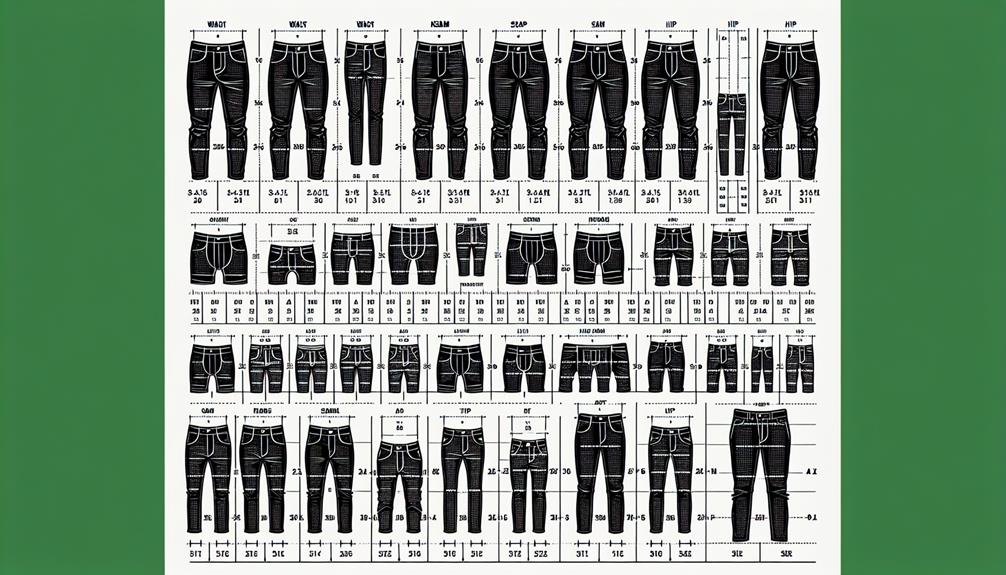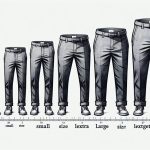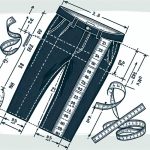Getting a grip on guys' pants sizes can be a puzzling pursuit. With various brands offering a multitude of fits, styles, and cuts, finding the perfect pair can seem like a challenging task. But fear not, as unraveling the mystery behind the pants size chart is the key to revealing a world of well-fitted trousers.
From deciphering waist measurements to exploring inseam lengths, this guide will equip you with the knowledge needed to confidently conquer the kingdom of men's pants sizing. Stay tuned to uncover the secrets of finding the ideal fit for your bottom half.
Table of Contents
Key Takeaways
- Knowing your measurements ensures comfortable and flattering pant fit.
- Choose waistband style and consider fabric stretch for accurate sizing.
- Proper inseam length is vital for the right drape and silhouette.
- Tailoring allows for a perfect fit by adjusting inseam length to match style and comfort.
Importance of Knowing Your Size
Understanding the importance of knowing your size is significant when shopping for pants to make sure a comfortable and flattering fit. When it comes to size accuracy, especially in the world of online shopping, having a clear understanding of your measurements can save you time and the hassle of returns. Different brands may have size consistency issues, leading to brand variations that can be confusing for the consumer. By knowing your exact measurements, you can navigate through these discrepancies more easily and make informed decisions when selecting the right size.
Online shopping adds another layer of complexity to the size accuracy dilemma. Without the ability to try on the pants before purchasing, knowing your size becomes even more important. By being aware of your measurements and understanding how they align with the sizing charts provided by the brands, you can increase the likelihood of getting pants that fit well without the need for returns or exchanges. Size consistency across brands may vary, so having a good grasp of your measurements can help you confidently shop for pants online.
Understanding Waist Measurements
Knowing how to accurately measure your waist is key to finding the right pants size for a comfortable and flattering fit. When it comes to understanding waist measurements, here are some essential points to take into account:
- Measure at the Right Spot: To get an accurate measurement, place the tape measure around your natural waistline, which is typically above the belly button.
- Consider Waistband Fit: Different styles like low-rise, mid-rise, or high-rise pants sit differently on the waist. Choose a waistband style that suits your preference and body shape.
- Understand Sizing Variations: Sizing can vary between brands, so it's important to refer to each brand's size chart and not rely solely on your usual size.
- Troubleshooting Sizing Issues: If you're between sizes, take into account the amount of stretch in the fabric and whether you prefer a tighter or looser fit.
- Try Before You Buy: When in doubt, try on the pants before purchasing to make sure the waistband fits comfortably and looks flattering.
Decoding Inseam Lengths
When it comes to choosing the right pair of pants, understanding inseam lengths is essential. Knowing the inseam measurement can make the difference between a comfortable fit and an awkward one.
Let's explore how to find the correct inseam and the option of tailoring for that perfect fit.
Inseam Measurement Importance
Deciphering the inseam lengths of pants is essential for finding the perfect fit. Understanding the inseam measurement can make a significant difference in how your pants look and feel. Here are some key points to keep in mind:
- Proper Length: Ensuring the inseam length matches your leg length is critical for the right fit.
- Fit Impact: Inseam length directly affects how the pants drape and the overall silhouette.
- Sizing Accuracy: Knowing your inseam measurement enhances accuracy when selecting pants.
- Tailoring Potential: Inseam length influences how easily pants can be tailored to fit perfectly.
- Styling Tips: Different inseam lengths can create various style effects, so choose wisely.
Finding Correct Inseam
Understanding how to decode inseam lengths plays a vital role in achieving the perfect fit for your pants. When finding the correct length, fit is key. Inseam adjustments or alterations may be necessary to guarantee your pants drape just right.
To decode inseam lengths, measure from the crotch to the bottom of the pant leg. Standard inseam lengths typically range from 30-36 inches. However, if you fall outside this range, consider alterations for a personalized fit.
Tailoring for Perfect Fit
To achieve a perfect fit for your pants, mastering the art of decoding inseam lengths is essential. When tailoring for the perfect fit, consider these key points:
- Fabric Selection: Choose the right fabric for your pants based on the desired look and comfort.
- Alterations: Understand the alterations needed to achieve the ideal inseam length for your body type.
- Custom Sizing: Opt for custom sizing if off-the-rack options don't provide the perfect inseam length.
- Fashion Trends: Stay updated on current fashion trends to make sure your pants' inseam length is on point.
- Personal Style: Tailor the inseam length to match your personal style and overall aesthetic.
Choosing the Right Fit Style
When it comes to selecting the best fit style for pants, it's important to consider factors like body shape, personal style, and comfort. Finding a fit that complements your physique while also aligning with your fashion preferences can make a significant difference in how you look and feel.
Additionally, exploring tailoring options can help customize your pants for a perfect fit.
Fit for Body Shape
Choosing the right fit style for your body shape is important for comfortable wearing and a flattering look. When considering body shape and fit, keep in mind sizing for athletic builds and proportions. Here are some key points to guide you in selecting the best fit for your body shape:
- Consider Your Body Shape: Understand if you have a more athletic build or if your proportions vary.
- Choose the Correct Waist Size: Make sure the waistband fits well without being too tight or loose.
- Pay Attention to Leg Fit: Opt for a style that complements your leg shape.
- Check the Inseam Length: Make sure the inseam length is suitable for your height.
- Try Different Styles: Experiment with different fits to find what suits you best.
Style and Comfort
Considering different body shapes and proportions, it's important to find a style that not only fits well but also provides comfort and complements your look.
When it comes to style trends, slim-fit pants are popular for a sleek silhouette, while straight-leg styles offer a more classic appeal.
Fabric choices play a significant role in comfort. Opt for breathable materials like cotton for everyday wear, or consider stretch fabrics for added flexibility.
Whether you prefer a modern or traditional look, the right fit style can enhance your overall appearance.
Experiment with different styles to see what suits you best, and don't be afraid to mix and match to create a unique style that reflects your personality.
Tailoring Options
Tailoring your pants to achieve the perfect fit can elevate your style and boost your confidence. When choosing the right fit style, consider the following:
- Fabric Options: Select a fabric that drapes well and is comfortable for all-day wear.
- Alteration Techniques: Explore options like hemming, tapering, or waist adjustments for a personalized fit.
- Custom Sizing: Opt for custom sizing if off-the-rack options don't provide the ideal fit.
- Style Preferences: Tailor your pants to match your style, whether it's a slim, straight, or relaxed fit.
- Experiment: Don't be afraid to experiment with different tailoring techniques to find what works best for you. Experimenting can lead to discovering new favorite styles tailored just for you.
Tips for Accurate Measurements
To confirm accurate measurements for your pants size, it's essential to follow these simple guidelines. When measuring for pants, precise techniques are critical for ensuring sizing accuracy. Use a flexible measuring tape to measure your waist at the narrowest point, usually around your belly button. For the inseam, measure from the crotch to the bottom of your ankle for an accurate length. Taking these measurements correctly will help you find the right fit and avoid size chart variations that can lead to fitting challenges.
When measuring your waist, make sure the tape is snug but not too tight to get an accurate number. Similarly, when measuring the inseam, stand up straight and have someone assist you for a precise measurement. Understanding these basic measuring techniques will empower you to select the right size from the pants size chart, ultimately overcoming fitting challenges that may arise from inaccurate measurements.
Using the Size Conversion Chart
When using the size conversion chart, you can easily match your measurements to the corresponding pant size for a perfect fit. Here are some size conversion tips and tricks that will help you find the perfect pair of pants:
- Understand International Sizing: Different countries may have varying size standards, so make sure to refer to a reliable size conversion chart.
- Measurements Matter: Take accurate measurements of your waist, hips, and inseam to guarantee a precise match with the chart.
- Consider Brand Variances: Brands sometimes have unique sizing, so it's crucial to check their specific size guides for accuracy.
- Try Before Buying: If possible, try on pants in-store to confirm the fit before making a purchase based solely on the conversion chart.
- Consult Customer Reviews: Reading reviews can provide insights into whether a brand's pants run true to size or if adjustments are necessary for a perfect fit.
Troubleshooting Common Sizing Issues
If you find yourself struggling with pant sizes despite following the conversion chart accurately, let's troubleshoot common sizing issues to guarantee a perfect fit.
Troubleshooting fit issues is important when dealing with pant sizes. One common problem is the waist being too tight or too loose. In this case, try adjusting the waistband or opting for a different style that suits your body shape better. Length can also be an issue, with pants being too long or too short. Hemming or cuffing can help solve these problems. Another sizing challenge is the fit around the hips and thighs. If your pants are too tight in these areas, consider going up a size or finding a more relaxed fit.
Sizing adjustments are key to achieving the right fit. Remember that different brands may have variations in their sizing, so don't hesitate to try on different sizes to find what works best for you. Pay attention to the fabric composition as well, as some materials may have less stretch than others. By troubleshooting fit issues and making sizing adjustments as needed, you can make sure your pants fit perfectly and comfortably.
Maintaining Your Pants Fit
Wondering how to keep your pants fitting just right over time? Here are some tips to maintain the fit of your pants:
- Belt Sizing: Make sure you're using the right belt size to prevent your pants from slipping or feeling too tight around the waist.
- Alterations: Consider getting your pants tailored for a perfect fit if you experience significant changes in your body shape.
- Fabric Care: Follow the care instructions on the label to preserve the quality and shape of your pants for longer.
- Wardrobe Coordination: Pair your pants with the right tops and shoes to create balanced outfits that complement your overall look.
- Regular Inspection: Check your pants for any signs of wear and tear, loose threads, or stretched-out areas that might affect the fit.
Frequently Asked Questions
How Can I Determine My Pants Size if I Don't Have a Measuring Tape?
If I lack a measuring tape for DIY size estimation, I'd recommend using a string or belt to measure my waist. I can then compare this length to online size calculators for a rough estimate.
Are There Any Specific Size Charts for Different Brands of Men's Pants?
When comparing different brands' size charts for men's pants, I find variations in fit. To style well, understanding each brand's sizing nuances is important. It's smart to check charts online or in-store for accurate measurements.
What Should I Do if My Waist and Inseam Measurements Fall Into Different Size Categories on the Chart?
If my waist and inseam measurements differ on the size chart, I'd explore size adjustment options or tailoring services. Mixing sizes for trouser length could be a solution. Prioritize fit for comfort and style.
Can the Fit Style of Pants Affect How They Will Sit on My Body?
Absolutely, fit preferences and body shape greatly influence how pants sit on me. Understanding different styles like slim or relaxed helps achieve the desired look. Tailoring options or alterations can further customize the fit.
Is It Possible to Alter the Size of Pants if They Don't Fit Perfectly?
If my pants don't fit perfectly, I can explore tailoring options or alteration services. Stretch fabric and adjustable waistbands also offer flexibility. It's possible to alter the size of pants for a better fit.
- The Use of Nonwovens in Construction and Civil Engineering - July 11, 2025
- The Use of Nonwovens in Construction and Civil Engineering - July 11, 2025
- The Use of Nonwovens in Construction and Civil Engineering - July 11, 2025







